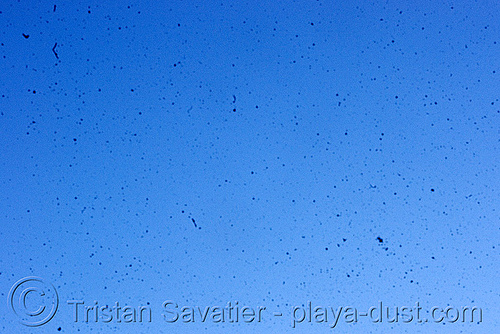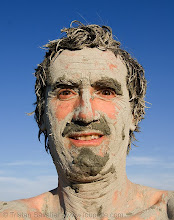- Fax me back the form at +1 415 704 3224 in superfine resolution (no need for a cover page). Please email me (tristan@bok.net) to confirm that the fax was sent.
- If you have no access to a fax, you can also email me (tristan@bok.net) a good digital photo or scan (e.g. pdf) of the signed form.
- Or you can send me the form by postal mail. email me (tristan@bok.net) to get my postal address.
Photographer Model Release
Contact Loupiote.com - Tristan Savatier
Phone: +1 415 763 7636 (US West Coast Time-zone)
Model Release Form
Loupiote on Instagram
How do you add the watermarks on your photos?
Several people have asked me that question: What do you use to make the watermarks on your photos?
To create the semi-transparent watermarks on my photos, I use Photoshop and ImageMagick (a server-side image manipulation program that can be scripted).
With Photoshop, I created custom "actions" and "droplets" (i.e. scripts that automate a series of commands) to add various layers with the watermark, using appropriate blending modes to give the semi-transparent effect. With ImageMagick, I wrote various server-side scripts to dynamically add some watermarking, e.g. when my images are shared with social networks like facebook, twitter, tumblr etc.
But creating those scripts this is quite complicated and require a very good knowledge of layers, blending modes and scripting, so I do not recommend this approach unless you are very good with Photoshop or know how to program scripts that use ImageMagick.
The good news is that there are web services that can add watermarks on your photos for free, like https://www.watermark-image.com, http://www.watermark.ws or http://picmarkr.com . Those probably work pretty well in most cases, so you should try them. I am sure there are other services like those, just google "watermark online" or "online watermarking".
Online Prints of Burning Man Photos: Is that commercial exploitation of the Artists's work?
On Smugmug there is currently no text description for any of my photos - I am working on that - but people arrive to Smugmug from my other sites only when they want to order a print, and the Smugmug galleries with Burning Man photos are password-protected.
Buy a Print, Canvas or Card online
You can now order high-quality prints and posters, cards, Fine Art archival prints and canvas prints of most of my photos on-line from my website (with no watermark, of course!). The prints orders are processed by fotomoto.com, a San Francisco based startup and provider of professional-quality prints. Prints are produced by Bay Photo Labs (Santa Cruz, California). They will redo prints if you are not satisfied by the quality and return them within 30 days.
- Click "Buy a Print" on the photo pages on my website (www.loupiote.com)
- Once in the Order Dialog, select the paper size and type, number of prints then Checkout (secured payment by Paypal or Credit Card)
Urgrade your Browser!
Widget shows in real-time what pages of your website others people are watching
I have added a cool free real-time statistics widget from whos.amung.us in the menu-bar on all my pages, including this one:
Cleaning Sensor Dust

Photo © Tristan Savatier - All Rights Reserved
This is a sensor test photo that i took at Burning Man 2008, with the diaphragm (aperture) closed to the maximum (i.e. maximum F-value, F32) shooting the blue sky. I have never seen as much dust on my sensor. Good thing I know how to clean a CCD sensor :)
I recommend a Giottos Rocket air blower to remove the bulk of the dust, then you can use the wet sensor swabs (with 100% pure methanol optical solution, also called methylic alcohol) to remove sticky particles that don't go with the air blower, if necessary.
Don't put more than a couple of drops of methanol on the swab, otherwise it would be too wet and leave deposit marks on the sensor. You will have to clean several times before getting a clean sensor, especially the first time. To clean, you must sweep the swab on the sensor from side to side. For best results, the width of the swab should the exact width of your sensor, so that you only need one sweep. Swabs made by Visible Dust. are excellent quality, I use those. After sweeping, put back the lens and do a test shot, then zoom on the image and check if there is still dust. usually the dust is located near the corners or near the edges. if you see dust, repeat the process.
To do a test shot, you must set the camera in A mode and close the apperture to the maximum F value (e.g. F32), and take a photo of something uniform, e.g. the sky or just a piece of paper. Set the camera to manual focus and make it completely out of focus, so if you see a dot on the test shot, it will be dust.
Sensor cleaning was painful at the beginning, it took me one hour to get all the dust OFF the first time. But now i can do it in two of three iterations, and it takes 10 min or so, and I am no the least nervous about doing it on my expensive camera.
Also, remember that if you have dust on your sensor, it will probably not show on your photos if you shoot with maximum apperture (i.e. minimum F value, e.g. F2.8 or F3.5). So if you have dust on the sensor and must continue to shoot with the dust, remember to shoot in A-mode (apperture priority) and use maximum apperture, i.e. use the minimum F value of your lens.
Dry-cleaning the sensor with rotating brushes charged with static electricity will work only with the dry, non-sticky particles on the sensor. But it will not cleanup sticky or greasy particles. Those can only be removed with a wet swab. So even if you get one of those dry cleaning brushes (e.g. Arctic Butterfly), sometimes you will still need to use the wet swabs.
NEVER ever use a spray can to blow away the dust inside the camera. The very cold gas out of the air-can would cause irreparable damage (micro-cracks) to your sensor.
There are other CCD cleaning options available, but that's what I use and it works well for me. Or you can pay a professional to do it, but it usually takes several days and it's not cheap, and this is not always possible if you travel. So you'd better learn how to do it yourself.
